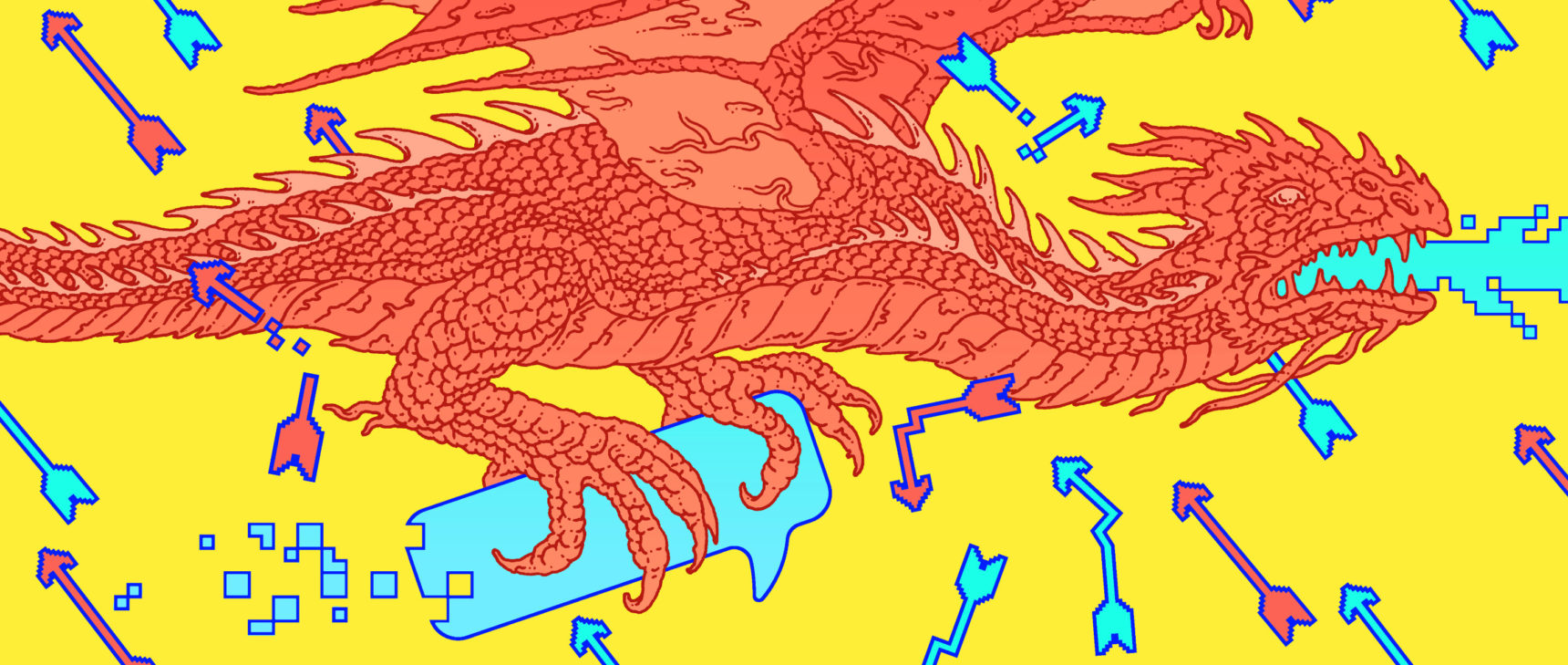Usain Bolt’s Split Times and the Power of Calculus
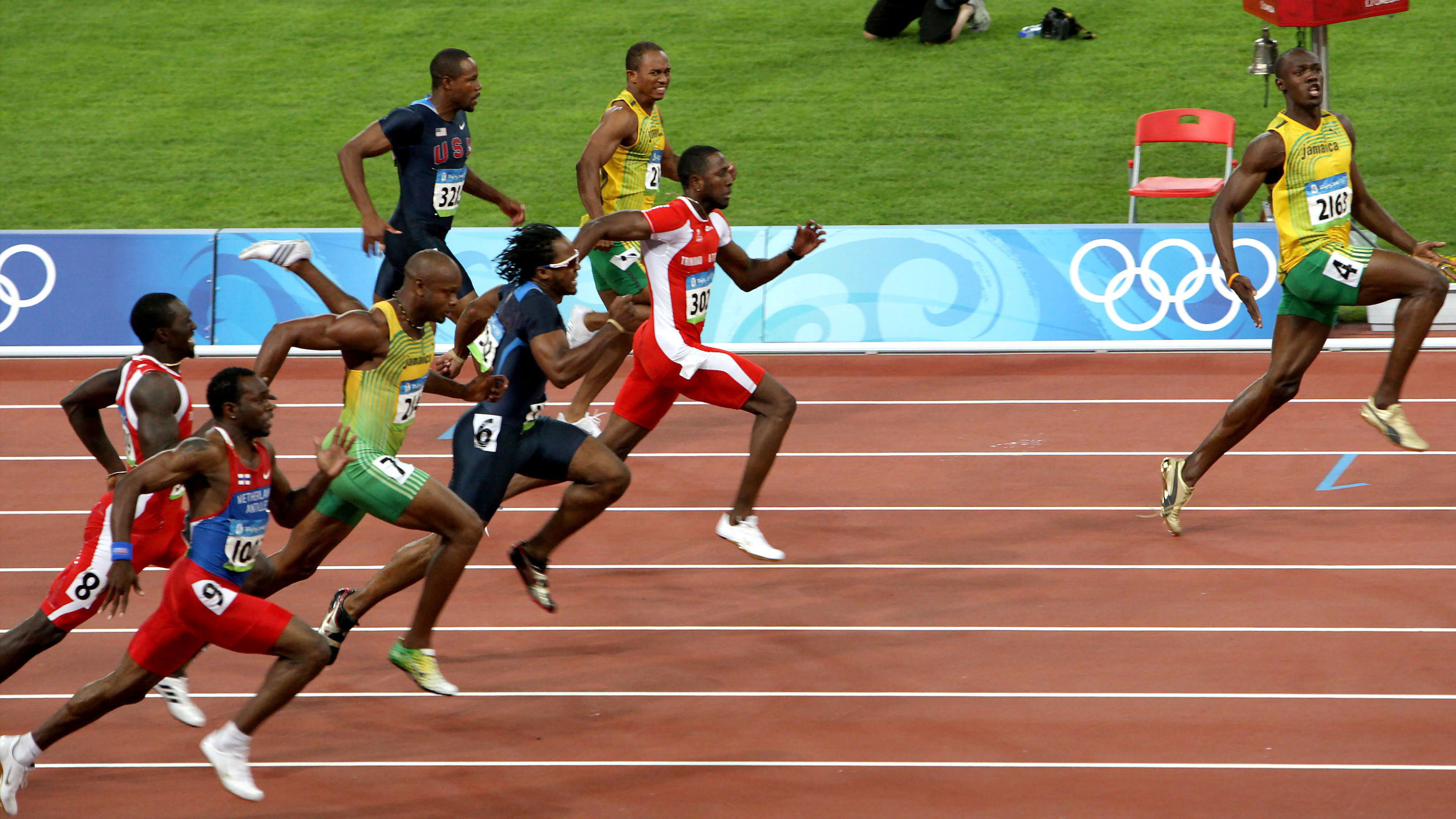
Usain Bolt easily won the 100-meter dash at the 2008 Beijing Olympics.
WENN Ltd / Alamy
Introduction
“Art,” said Pablo Picasso, “is a lie that makes us realize truth.” The same could be said for calculus as a model of nature. To see why, let me tell you a story about the fastest sprinter on the planet.
The evening of August 16, 2008, was windless in Beijing. At 10:30, the eight fastest men in the world lined up for the finals of the 100-meter dash. One of them, a 21-year-old Jamaican sprinter named Usain Bolt, was a relative newcomer to this event. Known more as a 200-meter man, he’d begged his coach for years to let him try running the shorter race, and over the past year he’d become very good at it.
He didn’t look like the other sprinters. He was gangly, 6 feet, 5 inches tall, with a long, loping stride. As a boy he had focused on soccer and cricket until his cricket coach noticed his speed and suggested that he try out for track. As a teenager he kept improving as a runner, but he never took the sport or himself too seriously. He was goofy and mischievous and had a fondness for practical jokes.
On that night in Beijing, after all the athletes had been introduced and finished mugging for the TV cameras, the stadium got quiet. The sprinters placed their feet in the blocks and crouched into position. An official called out, “On your marks. Set,” and then fired the starting pistol.
Bolt shot out of the blocks, but not quite as explosively as the other Olympians. His slower reaction time left him seventh out of eight near the start. Gaining speed, by 30 meters he moved up to the middle of the pack. Then, still accelerating like a bullet train, he put daylight between himself and the rest of the field.
At 80 meters, he glanced to his right to see where his main competitors were. When he realized how far ahead he was, he slowed down visibly, dropped his arms to his sides, and slapped his chest as he cruised across the finish line. Some commentators saw this as bragging, others as gleeful celebration, but in any case, Bolt clearly didn’t feel the need to run hard at the end, which led to speculation about just how fast he could have run. Even with his celebration (and an untied shoelace) he set a new world record of 9.69 seconds.
How fast did he run? Well, 100 meters in 9.69 seconds translates to $latex \frac {100}{9.69}=10.32$ meters per second. In more familiar units, that’s about 37 kilometers per hour, or 23 miles per hour. But that was his average speed over the whole race. He went slower than that at the beginning and end and faster than that in the middle.
More detailed information is available from his split times recorded every 10 meters down the track. He covered the first 10 meters in 1.83 seconds, corresponding to an average speed of 5.46 meters per second (12.2 miles per hour) there. His fastest splits occurred at 50 to 60 meters, 60 to 70 meters and 70 to 80 meters. He blazed through those 10-meter sections in 0.82 second each, for an average speed of 12.2 meters per second (27.3 miles per hour). In the final 10 meters, when he eased up and broke form, he decelerated to an average speed of 11.1 meters per second (24.8 miles per hour).
Human beings have evolved to spot patterns, so instead of poring over numbers like we’ve just been doing, it’s usually more informative to visualize them. The following graph shows the elapsed times at which Bolt crossed 10 meters, 20 meters, 30 meters, and so on, up to the 9.69 seconds it took him to cross the finish line at the 100-meter mark.
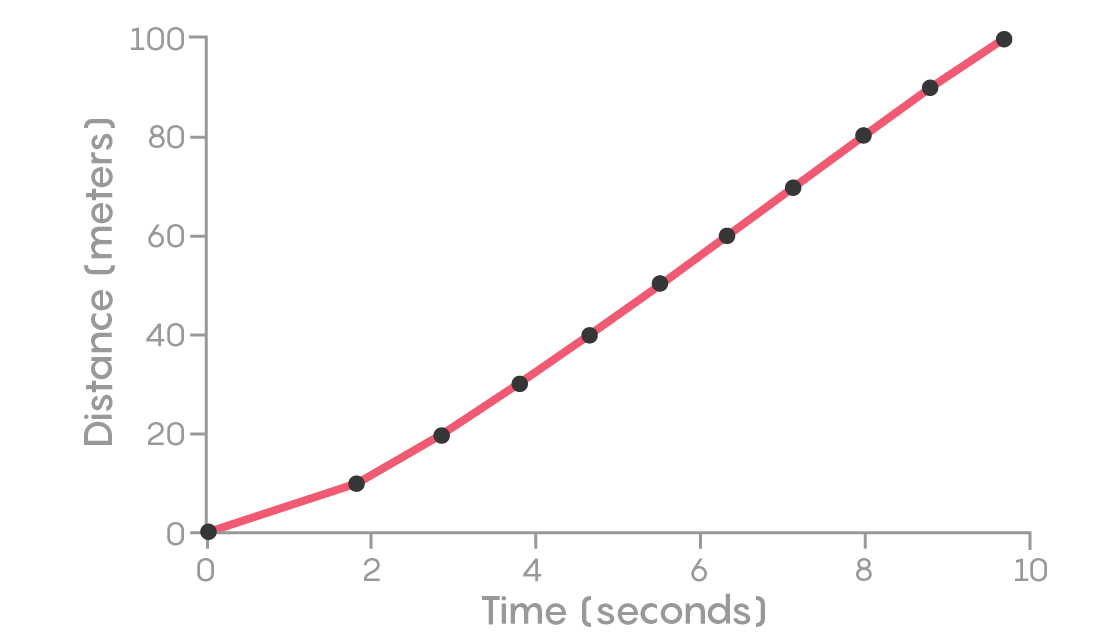
Adapted from Margaret Nelson
I’ve connected the dots with straight lines as a guide to the eye, but keep in mind that only the dots are real data. Together the dots and the line segments between them form a polygonal curve. The slopes of the segments are shallowest on the left, corresponding to Bolt’s lower speed at the start of the race. They bend upward as they move to the right; that means he’s accelerating. Then they join to form a nearly straight line, indicating the high and steady speed that he maintained for most of the race.
It’s natural to wonder at what time he was running his absolute fastest and where on the track that occurred. We know that his fastest average speed, over a 10-meter section, occurred somewhere between 50 and 80 meters, but an average speed over 10 meters is not quite what we want; we are interested in his peak speed. Imagine that Usain Bolt was wearing a speedometer. At what precise moment was he running the fastest? And exactly how fast was that?
What we’re looking for here is a way of measuring his instantaneous speed. The concept seems almost paradoxical. At any instant, Usain Bolt was at precisely one place. He was frozen, as in a snapshot. So what would it mean to speak of his speed at that instant? Speed can only occur over a time interval, not in a single instant.
The enigma of instantaneous speed goes far back in the history of mathematics and philosophy, to around 450 B.C. with Zeno and his redoubtable paradoxes. Recall that in his paradox of Achilles and the tortoise, Zeno claimed that a faster runner could never overtake a slower runner, despite what Usain Bolt proved that night in Beijing. And in his arrow paradox, Zeno argued that an arrow in flight could never move. Mathematicians are still unsure what point he was trying to make with his paradoxes, but my guess is that the subtleties inherent in the notion of speed at an instant troubled Zeno, Aristotle and other Greek philosophers. Their uneasiness may explain why Greek mathematics always had so little to say about motion and change. Like infinity, those unsavory topics seem to have been banished from polite conversation.
Two thousand years after Zeno, the founders of differential calculus solved the riddle of instantaneous speed. Their intuitive solution was to define instantaneous speed as a limit — specifically, the limit of average speeds taken over shorter and shorter time intervals.
For this strategy to succeed, we have to assume his distance down the track varied smoothly. Otherwise the limit we’re investigating won’t exist, and the results won’t approach anything sensible as the intervals get shorter. But did his distance actually vary smoothly as a function of time? We don’t know for sure. The only data we have are discrete samples of Bolt’s elapsed times at each of the 10-meter markers on the track. To estimate his instantaneous speed, we need to go beyond the data and make an educated guess about where he was at times in between those points.
A systematic way to make such a guess is known as interpolation. The idea is to draw a smooth curve between the data available. In other words, we want to connect the dots, not by straight-line segments as we’ve already done, but by the most plausible smooth curve that goes through the dots, or at least that goes very close to them. The constraints we impose on this curve are that it should be taut and not undulate too much; it should pass as close to all the dots as possible; and it should show that Bolt’s initial speed was zero, since we know he was motionless when he was in the crouch position. There are many different curves that meet these criteria. Statisticians have devised a host of techniques for fitting smooth curves to data. All of them give similar results, and since they all involve a bit of guesswork anyway, let’s not bother too much about which one to use.
Here’s one example of a smooth curve that meets all the requirements.
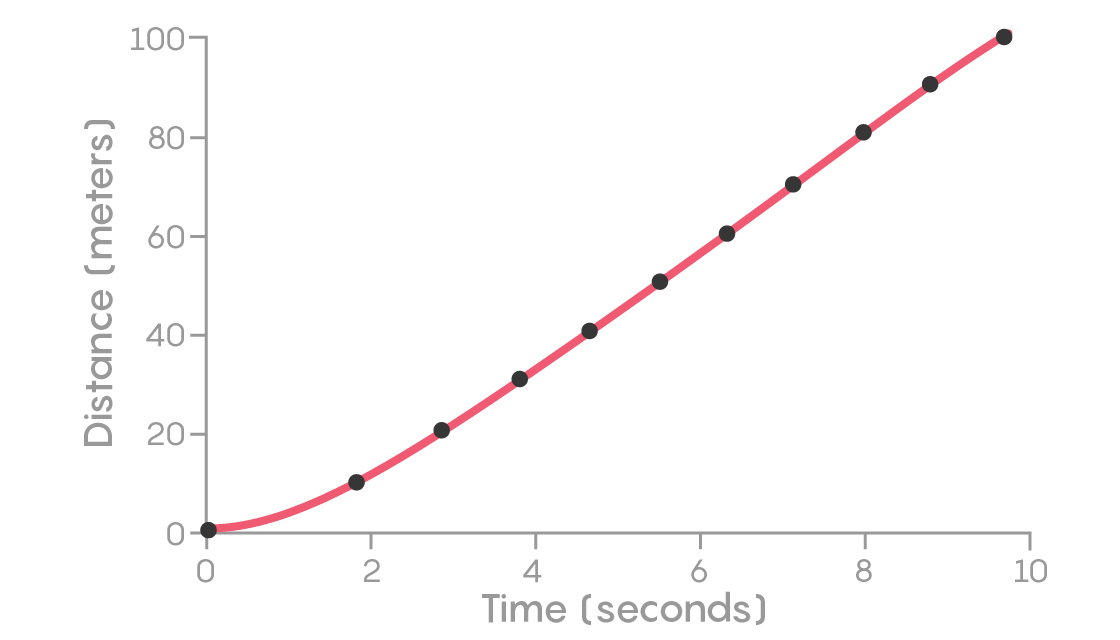
Adapted from Margaret Nelson
Since the curve is smooth by design, we can calculate its slope at every point. The resulting graph gives us an estimate of Usain Bolt’s velocity at each instant of his record-setting race that night in Beijing.
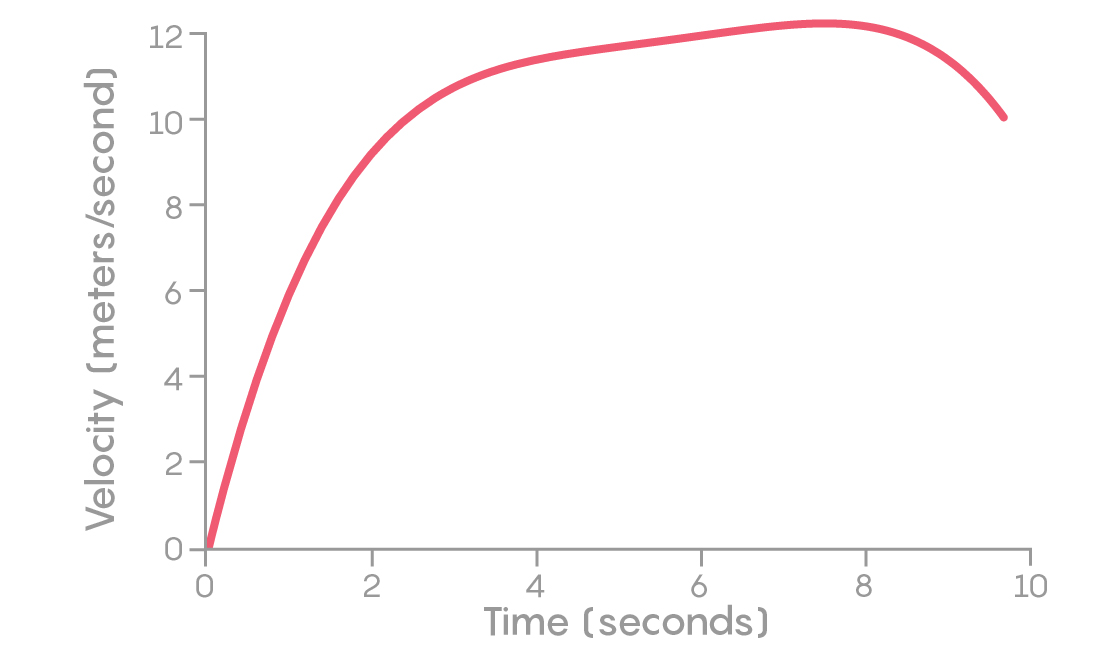
Adapted from Margaret Nelson
It indicates that Bolt reached a top speed of around 12.3 meters per second (27.5 miles per hour) at about the three-quarter point in the race. Until then, he’d been accelerating, gaining speed at each moment. After that he decelerated, so much so that his speed dropped to 10.1 meters per second (22.6 miles per hour) as he crossed the finish line. The graph confirms what everyone saw; Bolt slowed down dramatically near the end, especially in the last 20 meters, when he relaxed and celebrated.
The next year, at the 2009 World Championships in Berlin, Bolt put an end to the speculation about how fast he could go. He ran hard to the finish and shattered his Beijing world record of 9.69 seconds with an even more astonishing time of 9.58 seconds. Because of the great anticipation surrounding this event, biomechanical researchers were on hand with laser guns, similar to the radar guns used by police to catch speeders. These high-tech instruments allowed the researchers to measure the sprinters’ positions 100 times a second. When they computed Bolt’s instantaneous speed, this is what they found:
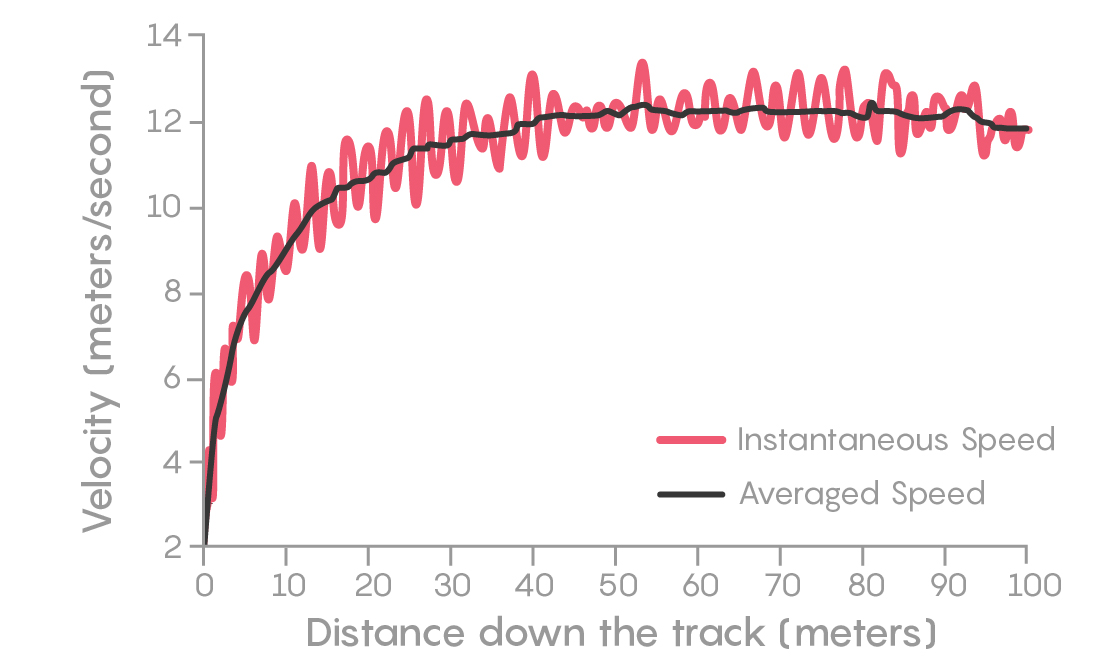
Adapted from IAAF 26:1/2; 19-53, 2011
The little wiggles on the overall trend represent the ups and downs in speed that inevitably occur during strides. Running, after all, is a series of leapings and landings. Bolt’s speed changed a little whenever he landed a foot on the ground and momentarily braked, then propelled himself forward and launched himself airborne again.
Intriguing as they are, these little wiggles are annoying and bothersome to a data analyst. What we really wanted to see was the trend, not the wiggles, and for that purpose, the earlier approach of fitting a smooth curve to the data was just as good and arguably better. After collecting all that high-resolution data and observing the wiggles, the researchers had to clean them off anyway. They filtered them out to unmask the more meaningful trend.
To me, these wiggles hold a larger lesson. I see them as a metaphor, a kind of instructional fable about the nature of modeling real phenomena with calculus. If we try to push the resolution of our measurements too far, if we look at any phenomenon in excruciatingly fine detail in time or space, we will start to see a breakdown of smoothness. In Usain Bolt’s speed data, the wiggles took a smooth trend and made it look as bushy as a pipe cleaner. The same thing would happen with any form of motion if we could measure it at the molecular scale. Down at that level, motion becomes jittery and far from smooth. Calculus would no longer have much to tell us, at least not directly. Yet if what we care about are the overall trends, smoothing out the jitters may be good enough. The enormous insight that calculus has given us into the nature of motion and change in this universe is a testament to the power of smoothness, approximate though it may be.
There’s one last lesson here. In mathematical modeling, as in all of science, we always have to make choices about what to stress and what to ignore. Galileo discovered the formula for the motion of a ball rolling down a ramp, but to find it, he had to ignore friction and air resistance. Isaac Newton used calculus and his laws of motion and gravity to explain why the planets move in elliptical orbits around the sun, but to do so he had to ignore the competing tugs of all the other planets in the solar system. The art of abstraction lies in knowing what is essential and what is minutia, what is signal and what is noise, what is trend and what is wiggle. It’s an art because such choices always involve an element of danger; they come close to wishful thinking and intellectual dishonesty. The greatest scientists, like Galileo and Newton, somehow manage to walk along that precipice.
Editor’s Note: The author of this column is a member of Quanta Magazine’s advisory board.



